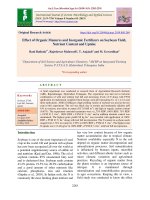Effect of nutrient management and micro-irrigation techniques on kharif pigeonpea (Cajanus cajan. L) under transplanted conditions on growth, yield and economics
Bạn đang xem bản rút gọn của tài liệu. Xem và tải ngay bản đầy đủ của tài liệu tại đây (237.41 KB, 7 trang )
Int.J.Curr.Microbiol.App.Sci (2018) 7(11): 3640-3646
International Journal of Current Microbiology and Applied Sciences
ISSN: 2319-7706 Volume 7 Number 11 (2018)
Journal homepage:
Original Research Article
/>
Effect of Nutrient Management and Micro-Irrigation Techniques on
kharif Pigeonpea (Cajanus cajan. L) under Transplanted Conditions
on Growth, Yield and Economics
C. Sudha Rani* and C. Sudhakar
Agricultural Research Station, Professor Jayashankar Telangana state Agricultural
University, Tandur, Vikarabad, Telangana state, 501141, India
*Corresponding author
ABSTRACT
Keywords
Drip irrigation,
Fertigation,
transplanted
Pigeonpea,
Vertisols, Nutrient
management and
micro-irrigation
Article Info
Accepted:
25 October 2018
Available Online:
10 November 2018
The Study was carried out on Pigeonpea (Cajanus cajan) with drip cum fertigation in
transplanted Pigeonpeain Vertisols (Black-cotton soils) at Agricultural Research Station,
Tandur, Vikarabad District, Telangana state, India. The experiment was conducted in
Split-plot design with three replications comprised of Irrigation levels (four I 1: 0.6, I2: 0.8:
I3:1.0 and I4:1.2 IW/CPE ratio as main plots based on Pan Evaporation and Fertility levels
three (F1: 75 % RDF, F2: 100 % RDF and F3: 125% RDF) as sub-plots. The test variety
was Asha ICPL 87119.Under drip cum fertigation system of Transplanted Pigeonpea
(variety ICPL 87119) irrigation with 120% of daily pan evaporation recorded significantly
highest seed yield (3014 kg/ha) which was supported by the Harvest index (24.4), number
of pods per plant (1020), Leaf area index LAI (4.37), radiation use efficiency (0.26 g/MJ)
and water use efficiency (4.33). Highest seed yields with 125% RDF through fertigation
was because of higher photosynthetic activity which resulted in better development of
pods (1006) 100 seed weight (10.2) and finally the water use efficiency (7.80 kg/ha/mm)
In this context, micro irrigation could play a key role in higher productivity and increased
water use efficiency (WUE) besides fulfilling sustainability mandates with economy in
use.
Introduction
Pigeonpea [Cajanus cajan (L.) Millsp.] is one
of the major grain legume crops of the tropics
and sub-tropics endowed with several unique
characteristics. It plays a major role in the
house hold economy of farmers by providing
protein rich food, firewood and income to the
resource poor small/marginal farmers in
tropics and subtropics and has long been
recognized for its attributes of high leaf fall
and consequent contribution to the carbon and
nitrogen economy of the soil (Rego and Rao,
2000). It finds an important position in the
cropping pattern adopted by small farmers in a
number of developing countries. Pigeonpea is
an important drought tolerant legume grown in
wide range of Agro-ecological situations. The
plant possesses valuable properties as
restorative of nitrogen to the soil and adds lots
3640
Int.J.Curr.Microbiol.App.Sci (2018) 7(11): 3640-3646
of organic matter to the soil and thus finds a
promising place in crop rotation and crop
mixtures. Being a leguminous plant, it is
capable of fixing atmospheric nitrogen and
there by restore nitrogen in the soil. The deep
rooting system helps in extracting the nutrients
and moisture from the deeper soil layers.
Pigeonpea occupies 6.5 per cent of the world’s
total pulse area and contributes 5.7 per cent to
the total pulse production. India is the largest
producer of pigeonpea accounting to about
64per cent of total world production. Among
the total pulses, pigeonpea a protein rich staple
food, accounts for 14.5 per cent in area and
15.5 per cent in productivity. In India it ranks
second in area and 91% of the world
Pigeonpea is produced in India. It is mainly
grown in states of Maharashtra, Uttar Pradesh,
Madhya Pradesh, Gujarat, Andhra Pradesh,
Telangana, Karnataka and Tamil Nadu and
these states constitute 90 per cent of the
area.Transplanting technique is a novel and
revolutionary agronomic approach to boost
Redgram yields. Transplanting technique in
Pigeonpea provides ample scope in enhancing
the yields and net returns of Pigeonpea
farmers under limited water availability
conditions in Telangana state especially in
ground water dependent areas. Normally
during years of low rainfall, the reproductive
phase of the crop coincides with moisture
stress conditions and associated terminal
drought situations. Any measure of advancing
the planting time reduces the risk from
terminal drought stress. But, late onset of
monsoons, which are being experienced more
frequently, doesn’t allow for timely sowing.
Time of sowing determines the time available
for vegetative growth before the onset of
flowering which is mainly influenced by the
photoperiod. Sowing time determines the plant
height, number of branches, flowering and pod
bearing habits. Thus time of sowing has
predominant influence on both vegetative and
reproductive process of Pigeonpea. In such
situations, raising the nursery in advance (in
the month of mid of May) and transplanting
the 30-45 days old redgram seedlings is the
best method to mitigate terminal drought
stress during poor rainfall years due to
enhanced rooting architecture. Preliminary
studies carried out at Agricultural Research
station, Tandur under rainfed conditions
revealed almost four fold increase (1760
kg/ha) in productivity compared to that of
average productivity over the conventional
system in the state (450 kg/ha). Deshmukh
(2010) also reported multifold advantages of
transplanting method in Redgram over
conventional sowing method. It saved input
cost in the form of less seed rate, less plant
protection etc. The transplanting technique
increased 2-3 fold yield (15.5 to 34.8 q/ha)
due to profuse branching and flowering.
Further, the crop can perform even better
under irrigated conditions. As transplanting
technique provides more opportunity time for
vegetative growth than in the conventional
planting system of sowing, it may respond
positively to the application of external inputs
i.e. plant nutrients and irrigation. Fertigation is
a relatively new but revolutionary concept in
applying fertilizer through irrigation as it helps
to achieve both fertilizer-use efficiency and
water-use efficiency. When fertilizer is
applied through drip, it is observed that30 per
cent of the fertilizer could be saved
(Sivanappan and Ranghaswami, 2005).Hence,
it is worthwhile to standardize the Agrotechniques to enhance the productivity of
Pigeonpea
crop.
At
this
juncture,
standardization of nutrient and water
management techniques would be of great
help.
Materials and Methods
The field experiment was conducted on deep
black cotton soils at Agricultural Research
Station, Tandur, Vikarabad (Dist.), Telangana
state of Professor Jayashankar Telangana state
Agricultural University for three consecutive
3641
Int.J.Curr.Microbiol.App.Sci (2018) 7(11): 3640-3646
Kharif seasons 2013-14, 2014-15 and 201516. The soil of the experimental site was
having PH 8.10, with low available nitrogen
(187.20 kgha-1), medium in available P (16.80
kgha-1) and high in available K (330.20 kg
ha-1) in all the years. The trial was laid out in
split-plot design with three replications
comprised of Irrigation levels (four I1: 0.6, I2:
0.8:I3:1.0and I4:1.2 IW/CPE ratio as main
plots based on Pan Evaporation and Fertility
levels (three F1: 75 % RDF, F2: 100 % RDF
and F3: 125% RDF) as sub-plots. The test
variety was Asha ICPL 87119.The irrigation
and fertilizers were applied with dripFertigation system. Irrigation control valve
was provided to each plot. The drip system
was established with dripper lines of 16mm
diameter laid along the crop rows at 1.5m
spacing with emitters spaced at 0.4m having a
flow rate of 2L per hour. Flow meters were
used to measure flow rates to each individual
treatment according to designated pan
evaporation replenishment factor. The
Recommended dose of fertilizers (20kg N, 50
kgP2O5 kg/ha and 10 K2O kg/ha) was applied
through Fertigation (water soluble fertilizers
MAP, Urea and KNO3) at weekly intervals
upto 100 days after transplanting starting at 20
days after planting.
The gross plot size was 13m x 12m and the
seedlings were transplanted at 30 days old at
150x 90cm @ 2-3 seedlings per hill. After
establishment one healthy seedling was left
and the remaining two seedlings were
removed by cutter just above the soil without
disturbing the root system of the hill. Crop
was managed as per the treatment. Leaf area
and intercepted radiation was measured with
LP-80 canopy analyzer from time to time. The
experimental data were analysed statistically
by following Fischer’s method of analysis of
variance as per procedure suggested by
Gomez and Gomez (1984). F–test was
significant at P=0.05 and the results have been
compared among treatments based on critical
difference.
The gross returns are worked out based on the
prevailing market rate of Pigeonpea seed (Rs.
80 per kg). The benefit cost ratio was worked
out for different treatments by dividing the net
returns by the corresponding cost of
cultivation of the treatments.
The RDF dose (20:50:10 NPK kg ha-1) was
used as base for calculating the fertigation
schedule. Fertigation was done once in seven
days starting from 20 DAT in three
consecutive steps viz., wetting the root zone
before Fertigation, fertigating the field and
flushing the nutrients with water. Irrigation
frequency is one of the most important factors
in drip irrigation scheduling. Due to
differences in soil moisture and wetting
pattern, crop yields may be different, when the
same quantity of water was applied under
different frequencies. Tumbare and Bhoite
(2002) concluded that weekly fertigation
through drip irrigation in14 equal splits
starting from the first week of transplanting
was beneficial for green chilli grown in a
sandy clay loam soil. Water use efficiency is
the yield of marketable crop produced per unit
of water used in evapotranspiration. In the
absence of new irrigation projects, bringing
more area under irrigation would mostly rely
on the efficient use of water.
Water use efficiency (WUE) is the amount of
yield that can be produced from given quantity
of water. It was worked out by using the
following formula and expressed as kg ha-1
mm-1.
WUE =Yield (kg ha-1) / Total water used
(mm)
Results and Discussion
Growth parameters
Pooled analysis of the growth parameters
(Plant height, primary branches, Secondary
branches, stem girth, LAI) during maturity
3642
Int.J.Curr.Microbiol.App.Sci (2018) 7(11): 3640-3646
stage were significantly influenced by
irrigation levels and Fertigation treatments but
their interaction effects were not significant
during all the years of study (Table 1). The
tallest plant stature with highest number of
primary and secondary branches and with
maximum leaf area index were recorded by I4
which was significantly higher than the I2and
I1. When compared to I1I2and I3, I4 received
adequate water for its growth and other
physiological activities hence recorded
maximum growth parameters leading to
higher yield attributes and yield. The stem
girth of pigeonpea was significantly
influenced by drip irrigation regimes and
fertigation levels during all the years of study
over surface method of irrigation. Irrigation
with 120% of daily pan evaporation recorded
significantly higher stem girth of 15.9 cm at
harvest, while the 125% recommended dose of
fertilizer registered highest stem girth of 10.5
cm at harvest. The normal sown pigeonpea
crop recorded with lesser stem girth (6.1 cm)
was observed at all stages with surface method
of irrigation and conventional method of
fertilizer application in all the years of study.
Seed yield
Under drip cum fertigation system of
Transplanted Pigeonpea (variety ICPL 87119)
irrigation with 120% of daily pan evaporation
recorded significantly highest seed yield (3014
kg/ha) which was supported by the Harvest
index (24.4), number of pods per plant (1020),
Leaf area index LAI (4.37), radiation use
efficiency (0.26 g/MJ) and water use
efficiency
(4.33).
In
this
context,
microirrigation could play a key role in higher
productivity and increased water use
efficiency
(WUE)
besides
fulfilling
sustainability mandates with economy in use.
Adoption of micro irrigation helps in raising
the irrigated area, crop productivity and WUE
(Sivanappan, 1985). The results obtained from
the experiment with four different irrigations
based on IW/CPE ratios of120, 100, 80 and 60
per cent in Pigeonpea indicated that under
conditions of unlimited water, I4 treatment
seemed to be the best as it recorded 3014
kg/ha yield, which was 75% higher than the I1
(Table 2). The benefit cost ratio ranged from
2.54 to 4.56, while the water use efficiency
ranged from 3.09 to 4.33 due to drip irrigation
from I1to I4. The same treatment I4 recorded
highest net returns (Rs.1,39,297-00 per
hectare) and Benefit cost ratio (4.56). Seed
yield of I4 is fbI3, I2 and I1 as indicated in
Table No.1 and the results concurrent with the
reports of Sunil Kumar and Jadhav 2007.
Of the three fertility levels 125%
recommended dose of water soluble fertilizers
(MAP, Urea and KNO3) registered highest
seed yield (2461 kg/ha), but was on par with
100% recommended dose of water soluble
fertilizers (MAP, Urea and KNO3)(2401
kg/ha). Highest seed yields recorded under
Transplanted
situation
with
125%
recommended dose through fertigation was
because of higher photosynthetic activity
(positive influence on radiation use efficiency
0.27 g/MJ), effective translocation of
photosynthates from source to sink (harvest
index 24.5) which resulted in better
development of pods (1006) 100 seed weight
(10.2) and finally the water use efficiency
(7.80 kg/ha/mm) which might have final
positive effect on yield and Net returns
(Rs.1,08,001 per ha) and Benefit cost ratio
(3.67). The results coincided with the findings
of Telgate et al., (2004). Higher yields are also
due to profuse growth leading to better
primary
branching
(16.3),
secondary
branching (10.3) LAI (4.32), stem girth (14.3
cm).
Economics
One of the main objectives of fertigation is to
reduce the cost of cultivation and to increase
the economic product as high as possible.
3643
Int.J.Curr.Microbiol.App.Sci (2018) 7(11): 3640-3646
Table.1 Effect of drip-fertigation on growth of Transplanted Redgram during Kharif (2013-14, 2014-15 and 2015-16 pooled analysis)
Treatments
A) Main plots – 4 Spacings
I1 -60 % of daily pan Evaporation
I2-80 % of daily pan Evaporation
I3- 100 % of daily pan Evaporation
I4- 120 % of daily pan Evaporation
Sem+
C.D. (p=0.05)
B) Sub-plots – 3 Fertility levels
F1- 75 % of RDF
F2- 100 % of RDF
F3- 125 % of RDF
Sem+
C.D (p=0.05)
Interaction (A X B)
Sem+
C.D (p=0.05)
Plant height
(cm)
Primary
branches
Secondary
branches
Stem girth
(cm)
LAI
RUE
(g/MJ)
198
205
212
218
4.48
NS
12.0
14.0
17.0
20.2
1.32
2.91
5.2
6.3
8.5
9.0
0.35
1.78
12.0
13.3
14.0
15.9
0.18
1.16
2.20
3.81
4.19
4.37
0.23
0.25
0.26
0.26
199
210
222
2.04
NS
11.4
14.4
16.3
1.10
2.81
7.9
9.8
10.5
0.44
1.08
13.4
13.7
14.3
0.34
NS
2.97
3.64
4.32
0.23
0.25
0.27
12.35
NS
-
1.27
NS
-
1.2
NS
-
0.63
NS
-
-
-
*RDF (Recommended dose of fertilizer): 20:50:10 N, P 2O5 and K2O
3644
Int.J.Curr.Microbiol.App.Sci (2018) 7(11): 3640-3646
Table.2 Effect of drip-fertigation on yield and economics of Transplanted Redgram during Kharif (2013-14, 2014-15 and 2015-16
pooled analysis)
Treatments
A) Main plots – 4 Spacings
I1 -60 % of daily pan Evaporation
I2-80 % of daily pan Evaporation
I3- 100 % of daily pan Evaporation
I4- 120 % of daily pan Evaporation
Sem+
C.D. (p=0.05)
B) Sub-plots – – 3 Fertility levels
F1- 75 % of RDF
F2- 100 % of RDF
F3- 125 % of RDF
Sem+
C.D (p=0.05)
Interaction (A X B)
Sem+
C.D (p=0.05)
Seed yield
(Kg/ha)
Number of
pods
Harvest index
Net returns
(Rs)
BC ratio
22.4
23.3
23.8
24.4
0.3
1.97
100 seed
weight
(gm)
9.7
9.9
10.26
10.34
0.06
0.37
69191
87729
115969
139297
3117
20658
2.54
3.09
3.93
4.56
0.11
0.69
WUE
(kg/ha
mm)
3.09
4.12
4.23
4.33
-
1727
2092
2585
3014
53.66
355
733
840
974
1020
35.2
NS
2186
2401
2461
63.34
261
791
878
1006
50.35
151.0
22.4
23.5
24.5
0.29
0.87
9.7
10.1
10.2
0.08
0.34
95223
105916
108001
3551
10646
3.39
3.64
3.67
0.12
NS
7.2
7.5
7.8
-
162.1
NS
100.7
NS
-
0.89
NS
0.18
NS
9385
NS
0.32
NS
-
*RDF (Recommended dose of fertilizer): 20:50:10 N, P2O5 and K2O
3645
Int.J.Curr.Microbiol.App.Sci (2018) 7(11): 3640-3646
Therefore getting maximum benefits from
each unit of water and nutrient applied to crop
are important. A technically feasible level of
fertigation with straight and water soluble
fertilizer through drip would be economically
viable for its successful adoption. The benefit
cost ratio ranged from 2.54 to 4.56 due to drip
irrigation from I1to I4. Drip irrigation with
120% of daily pan evaporation recorded
maximum net returns (Rs. 1,39,297 ha-1) and
benefit cost ratio (4.56) as compared to low
level of drip irrigation at 60% of daily pan
evaporation. Water-soluble fertilizers were
found to be better source for fertigation than
the normal fertilizers as they resulted in less
clogging (Venkateshamurthy, 1997).Of the
three fertility levels 125% RDF recorded
maximum net returns (Rs, 1,08,001 ha-1) and
benefit cost ratio (3.67) as compared to 75%
RDF.
In conclusion, pooled results of the trial
indicated that it is better to go for irrigation by
drip irrigation system with 120% of daily pan
evaporation to Pigeonpea under transplanted
conditions. Of the fertility levels 100% RDF
recorded highest Pigeonpea yield with
Fertigation.
References
Gomez, K. A. and Gomez A. A. (1984).
Statistical Procedures for Agricultural
Research. John Wiley and Sons, New
York.
Rego, T. J and Nageshwara Rao, V. (2000)
Long - term effects of grain legumes on
rainy-season sorghum productivity in a
semiarid
tropical
vertisol.
Experimental Agriculture. 36:205-221
Sunil Kumar and Jadhav, N. M. R. L. (2007).
The method of transplanting to get
higher yield in red gram. Annadatha,
pp. 18-20
Sivanappan, R. K. 1985. In Drip Irrigation in
Action, Vol. II, ASAE, Michigam, pp.
736-740.
Sivanappan, R.K and Ranghaswami, M.V.
(2005). Technology to take 100 tons per
acre in sugarcane. Kisan World, 32: 3538
Telgate, N. C., Alur, R. P., Parmar, J.
N.(2004). Effect of fertility levels on
yield of pigeonpea.
Tumbare, A. D. and S. V. Bhoite. (2002).
Effect of solid soluble fertilizer applied
through fertigation on growth and yield
of chilli. Indian J. Agrl. Sci., 72(2):109111.
Venkateshamurthy, P. (1997). Studies on
fertigation in Bangalore blue grapescomparison of sources and levels of
nutrients. Ph.D. (Hort.) Thesis, Univ.,
Agric. Sci., Bangalore.
How to cite this article:
Sudha Rani, C. and Sudhakar, C. 2018. Effect of Nutrient Management and Micro-Irrigation
Techniques on kharif Pigeonpea (Cajanus cajan. L) under Transplanted Conditions on Growth,
Yield and Economics. Int.J.Curr.Microbiol.App.Sci. 7(11): 3640-3646.
doi: />
3646

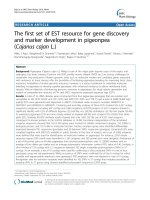
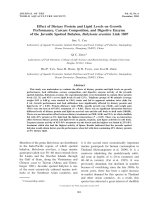


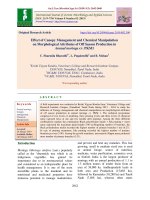
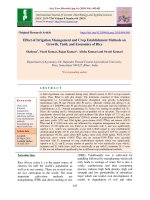
![Effect of fertility levels and stress mitigating chemicals on nutrient uptake, yield and quality of mungbean [Vigna radiata (L.) Wilczek] under loamy sand soil of Rajasthan](https://media.store123doc.com/images/document/2020_01/09/medium_ftp1578562755.jpg)
